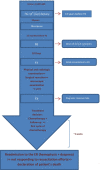An invasive mole with pulmonary metastases in a 55-year-old postmenopausal Syrian woman: a case report and review of the literature
- PMID: 33455574
- PMCID: PMC7812724
- DOI: 10.1186/s13256-020-02630-3
An invasive mole with pulmonary metastases in a 55-year-old postmenopausal Syrian woman: a case report and review of the literature
Abstract
Background: Invasive mole is a subtype of gestational trophoblastic neoplasms (GTNs) that usually develops from the malignant transformation of trophoblastic tissue after molar evacuation. Invasive moles mostly occur in women of reproductive age, while they are extremely rare in postmenopausal women.
Case presentation: We present the case of a 55-year-old postmenopausal Syrian woman who was admitted to the emergency department at our hospital due to massive vaginal bleeding for 10 days accompanied by constant abdominal pain with diarrhea and vomiting. Following clinical, laboratory and radiological examination, total hysterectomy with bilateral salpingo-oophorectomy was performed. Histologic examination of the resected specimens revealed the diagnosis of an invasive mole with pulmonary metastases that were diagnosed by chest computed tomography (CT). Following surgical resection, the patient was scheduled for combination chemotherapy. However, 2 weeks later the patient was readmitted to the emergency department due to severe hemoptysis and dyspnea, and later that day the patient died in spite of resuscitation efforts.
Conclusion: Although invasive moles in postmenopausal women have been reported previously, we believe our case is the first reported from Syria. Our case highlights the difficulties in diagnosing invasive moles in the absence of significant history of gestational trophoblastic diseases. The present study further reviews the diagnostic methods, histological characteristics and treatment recommendations.
Keywords: Gestational trophoblastic neoplasms; Invasive mole; Postmenopausal woman; Pulmonary metastases.
Conflict of interest statement
The authors declare that they have no competing interests.
Figures














References
-
- de la Fouchardière A, Cassignol A, Benkiran L. Môle hydatiforme invasive chez une patiente ménopausée [Invasive hydatiform mole in a postmenopausal woman] Ann Pathol. 2003;1:443–446. - PubMed
Publication types
MeSH terms
LinkOut - more resources
Full Text Sources
Other Literature Sources
Medical

